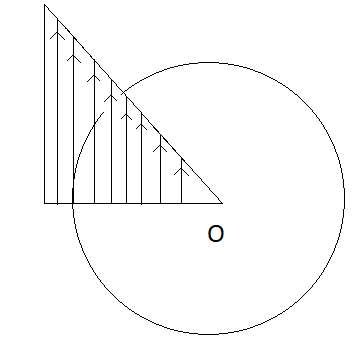
The shear stress which is induced in the shaft due to the applied couple varies:
(A) From maximum at the centre to the zero at the circumference
(B) From zero at the centre to the maximum at the circumference
(C) From maximum at the centre to the minimum at the circumference
(D) From minimum at the centre to the maximum at the circumference
Answer
455.4k+ views
Hint: As we know stress in material’s resistance to the applied force acting on it. The deformation caused by this applied force is known as strain. The question says that the couple is applied on the shaft. This will induce a stress in the fibres of the shaft. It’s variation along the radius will be different.
Complete Step By Step Answer:
A shaft is made from some kind of materials which are made up with fibers which will come into stretch when the couple is applied. When the torsion or twist is applied along the cross section of the shaft.
This will be forming a distribution of stresses along the cross section of the shaft. The shear stress actually generates this sliding of the fibres over one another. Let us take a look at the central axis first.
The central axis will be like a long thread and originally will not have any fibres sliding over one another, As mentioned earlier it is a long thread like entity and will not have a shear stress induced. As we go away from this central axis the number of these induced stresses go on increasing.
This will give us the idea that the value of shear stress in a shaft which is induced due to a couple varies from zero at the centre to the maximum at the circumference.

We can also derive that from the equation as,
$ \tau = \dfrac{{Tr}}{I}$
$ \tau $ is shear stress
T is applied torque
R is distance from the centre
I is polar moment of inertia
If we can identify from the equation
At r=0 the stress is zero
At r=r the stress is maximum for any value of r.
Hence, option (B) is correct.
Note:
Ratio of stress and strain will give us the modulus. There are different modulus like Young’s modulus, Bulk modulus, Modulus of rigidity.
Poisson’s ratio is the ratio of lateral strain to the longitudinal strain. The Poisson’s ratio will form the relations between the different modulus.
Complete Step By Step Answer:
A shaft is made from some kind of materials which are made up with fibers which will come into stretch when the couple is applied. When the torsion or twist is applied along the cross section of the shaft.
This will be forming a distribution of stresses along the cross section of the shaft. The shear stress actually generates this sliding of the fibres over one another. Let us take a look at the central axis first.
The central axis will be like a long thread and originally will not have any fibres sliding over one another, As mentioned earlier it is a long thread like entity and will not have a shear stress induced. As we go away from this central axis the number of these induced stresses go on increasing.
This will give us the idea that the value of shear stress in a shaft which is induced due to a couple varies from zero at the centre to the maximum at the circumference.

We can also derive that from the equation as,
$ \tau = \dfrac{{Tr}}{I}$
$ \tau $ is shear stress
T is applied torque
R is distance from the centre
I is polar moment of inertia
If we can identify from the equation
At r=0 the stress is zero
At r=r the stress is maximum for any value of r.
Hence, option (B) is correct.
Note:
Ratio of stress and strain will give us the modulus. There are different modulus like Young’s modulus, Bulk modulus, Modulus of rigidity.
Poisson’s ratio is the ratio of lateral strain to the longitudinal strain. The Poisson’s ratio will form the relations between the different modulus.
Recently Updated Pages
Class 11 Question and Answer - Your Ultimate Solutions Guide

Master Class 11 Accountancy: Engaging Questions & Answers for Success

Master Class 11 Physics: Engaging Questions & Answers for Success

Master Class 11 Business Studies: Engaging Questions & Answers for Success

Master Class 11 Maths: Engaging Questions & Answers for Success

Master Class 11 Chemistry: Engaging Questions & Answers for Success

Trending doubts
1 ton equals to A 100 kg B 1000 kg C 10 kg D 10000 class 11 physics CBSE

Difference Between Prokaryotic Cells and Eukaryotic Cells

One Metric ton is equal to kg A 10000 B 1000 C 100 class 11 physics CBSE

What is the opposite of entropy class 11 chemistry CBSE

Proton was discovered by A Thomson B Rutherford C Chadwick class 11 chemistry CBSE

1 Quintal is equal to a 110 kg b 10 kg c 100kg d 1000 class 11 physics CBSE




